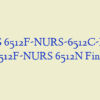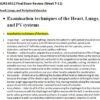Description
NURS 6512N Week 1 Quiz (40 out of 40)
- A 60-year-old African-American man lives with a number of chronic health problems. Genetic factors are likely to influence his etiology and/or treatment of
- 30 ml = _______________tbsp
- A home health nurse notes that there have been changes to a patient’s oral drug regimen. The nurse will closely monitor the new drug regimen to
- A patient with a variety of chronic health problems is being seen by her nurse practitioner, who is currently reviewing the patient’s medication regimen. Which of the patient’s medications should prompt the nurse to teach her to avoid drinking grapefruit juice?
- For which of the following patients would a nasogastric tube most likely be considered to aid in the administration of medications?
- The nurse’s assessment of a community-dwelling adult suggests that the client may have drug allergies that have not been previously documented. What statement by the client would confirm this?
- Which of the following statements best defines how a chemical becomes termed a drug?
- Talwin given in combination with Vistaril diminishes the adverse effects of nausea caused by the Talwin. This drug interaction affecting the pharmacodynamics of the Talwin is
- A patient has been prescribed 1 mg lorazepam (Ativan) sublingual prior to the scheduled insertion of a peripherally inserted central (PIC) line. How should the nurse direct the patient when administering this medication?
- In response to a patient’s nausea, the nurse has mixed a dose of an antiemetic with 50 mL of sterile normal saline and will administer the dose by IV piggyback. What is the rationale for the use of IV piggyback?
- A patient has been prescribed an oral drug that is known to have a high first-pass effect. Which of the following measures has the potential to increase the amount of the free drug that is available to body cells?
- An older adult patient with a history of Alzheimer’s disease and numerous chronic health problems has been prescribed several medications during his current admission to hospital and recent declines in the patient’s cognition have impaired his ability to swallow pills. Which of the following medications may the nurse crush before administering them to this patient?
- A patient has been prescribed several drugs and fluids to be given intravenously. Before the nurse starts the intravenous administration, a priority assessment of the patient will be to note the
- A nurse is caring for a patient who has recently moved from Vermont to south Florida. The patient has been on the same antihypertensive drug for 6 years and has had stable blood pressures and no adverse effects. Since her move, however, she reports “dizzy spells and weakness” and feels that the drug is no longer effective. The nurse suspects that the change in the effectiveness of the drug is related to
- In which of the following patients would a nurse expect to experience alterations in drug metabolism?
- A patient who has ongoing pain issues has been prescribed meperidine (Demerol) IM. How should the nurse best administer this medication?
- A mother brings her 4-year-old child, who is vomiting and has a temperature of 103°F into the emergency department (ED). The ED physician orders acetaminophen (Tylenol) for the fever. The best form of Tylenol to give the child, considering her presentation, would be
- A patient has been receiving regular doses of an agonist for 2 weeks. Which of the following should the nurse anticipate?
- A patient with a recent diagnosis of acute renal failure has a long-standing seizure disorder which has been successfully controlled for several years with antiseizure medications. The nurse should recognize that the patient’s compromised renal function will likely
- A nurse is caring for a patient who has had part of her small intestine removed due to cancer. She has also now developed hypertension and has been prescribed a new medication to decrease her blood pressure. While planning the patient’s care, the nurse should consider a possible alteration in which of the following aspects of pharmacokinetics?
- During a clinic visit, a patient complains of having frequent muscle cramps in her legs. The nurse’s assessment reveals that the patient has been taking over-the-counter laxatives for the past 7 years. The nurse informed the patient that prolonged use of laxatives
- A nurse is caring for a postsurgical patient who has small tortuous veins and had a difficult IV insertion. The patient is now receiving IV medications on a regular basis. What is the best nursing intervention to minimize the adverse effects of this drug therapy?
- Which of the following affects drug distribution throughout the body?
- 5 ml = _______________tsp
- A 56-year-old female patient has been admitted to the hospital with chronic muscle spasms and has been prescribed a new medication to treat the spasms. She has a poorly documented allergy to eggs, synthetic clothes, and perfumes. What is the priority action of the nurse to ensure that prescribed medication does not experience an allergic reaction?
- A nurse is conducting an assessment of a patient who has recently had several changes made to her drug regimen. What assessment question most directly addresses the safety implications of the patient’s drug regimen?
- Mr. Lacuna is an 83-year-old resident of a long-term care facility who has a diagnosis of moderate Alzheimer disease. Mr. Lacuna’s physician recently prescribed oral rivastigmine, but he was unable to tolerate the drug due to its gastrointestinal effects. As a result, he has been ordered the transdermal patch form of the medication. When administering this form of rivastigmine, the nurse should
- A 72-year-old man who is unable to sleep since admission into the hospital is given a hypnotic medication at 9 p.m. The nurse finds the patient drowsy and confused at 10 a.m. the next day. The nurse is aware that this behavior is most likely due to
- A 77-year-old man with a long history of absence seizures has been treated with ethosuximide for many years. The man is now in the process of moving to a long-term care facility and a nurse is creating a plan of care. The nurse understands the potential adverse effects of this drug and would consequently prioritize which of the following nursing diagnoses?
- Before the administration of morphine to a 65-year-old man who has cancer, the initial action of the nurse would be to check the patient’s
- A 79-year-old woman has been admitted to the hospital with a gastrointestinal bleed. She is currently receiving a transfusion of packed red blood cells as well as an infusion of pantoprazole (Protonix), a proton-pump inhibitor, to help stop her bleeding. What care setting is most appropriate for this patient?
- A nurse is administering drugs to a 70-year-old patient who has a reduced plasma albumin level. When assessing the patient for therapeutic outcomes of drug therapy, the nurse will also be careful to observe for
- A nurse is caring for an 81-year-old patient in a long-term care facility who takes nine different medications each day. The patient has a recent diagnosis of seizure disorder and has begun treatment with phenytoin (Dilantin), a highly protein-bound drug. After 1 month of Dilantin therapy, the patient is still extremely drowsy and sluggish. The nurse determines that the prolonged adverse effect is likely due to
- Mr. Penny, age 67, was diagnosed with chronic angina several months ago and has been unable to experience adequate relief of his symptoms. As a result, his physician has prescribed ranolazine (Ranexa). Which of the following statements is true regarding the use of ranolazine for the treatment of this patient’s angina?
- An elderly man has been admitted to a residential care facility and the nurse has conducted a medication reconciliation. The man has taken numerous drugs in the past, including a course of bicalutamide (Casodex) several years earlier. The nurse recognizes this drug as being an antiandrogen and is consequently justified in presuming that the man has a history of what disease?
- A nurse notes new drug orders for a patient who is already getting several medications. Which of the following is the most important consideration when preparing to administer the new drugs?
- A nurse who is working with an older adult patient who takes eight medications a day wants to promote medication adherence. Which of the following nursing interventions would best promote medication adherence?
- A 66-year-old woman has a complex medical history that includes poorly-controlled type 1 diabetes, renal failure as a result of diabetic nephropathy and chronic heart failure (CHF). Her care provider has recently added spironolactone (Aldactone) to the woman’s medication regimen. The nurse should consequently assess for signs and symptoms of
- Medication reconciliation of an 82-year-old man who has recently moved to a long-term care facility reveals that the man takes 1 to 2 mg of lorazepam bid prn. The nurse should recognize what consequence of this aspect of the resident’s drug regimen?
- Mr. Nguyen, age 71, will soon be discharged home from the hospital after a successful coronary artery bypass graft (CABG). During patient education about his drug regimen, Mr. Nguyen’s nurse should prioritize teach about







